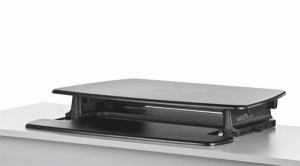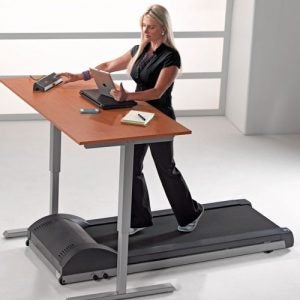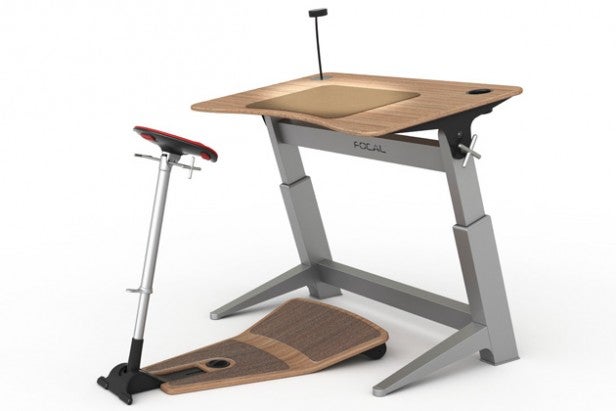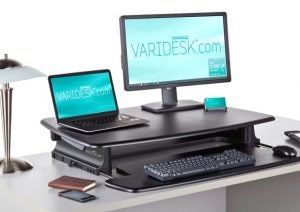Living With A Standing Desk: Is it worth trying?

One month living with a standing desk
Are there any real benefits to using a standing desk? To find out, we set Edward Chester the challenge of using one for a month. Here’s his diary of what he found.
Recent studies into the health risks involved in sitting all day have prompted many to start looking into alternative ways of working at a desk. To avoid the greater risk of heart disease, colon cancer, postural problems, and much more besides many people are turning to standing at their desks, while some are even walking on treadmills or using exercise bikes while they work.
The logic is simple: spending more time standing or moving your lower body engages more muscles so it burns more calories, promotes better posture, increases blood flow to your extremities and thus improves alertness.
While some people have suggested this is reason enough to ditch sitting altogether, others have countered that simply getting up and walking at regular intervals is enough to have the same effect – not to mention, standing all day has plenty of downsides too (varicose veins, anyone?).
So, to put the idea of the standing desk to the test, TrustedReviews asked me to give it a go.
To test the standing desk theory we got hold of a Varidesk. This clever device allows you to convert a normal desk into a standing desk, and back again at will. Place all your computer peripherals and other desk items on its top surface and at the touch of a couple of buttons – and with a bit of brute force – the top surface can be raised to a comfortable standing desk height.
To give the standing desk theory a decent run I used it for four weeks, tracking my thoughts along the way. Here’s how it went…
Featured image credit: Tom Carmony
Week One: The mind is willing but the body is not
My first impressions of the standing desk largely centred on the Varidesk itself, and overall they were very positive. You can read my full Varidesk Pro review but in short it’s really easy to setup, is well made and very easy to operate. It took all of half an hour from opening the box to being up and running… well, standing.
As for my first impressions of actually standing, they were largely very good.
The effect almost seems to be more pronounced with these first few days as my body is so unused to standing for long periods of time that it almost feels unsteady, requiring constant corrections from core and leg muscles. In fact, so poorly equipped was I that after only 20 or so minutes of standing I was fidgeting almost constantly as I tried to ward off the soreness in my feet, thighs, calves and lower back – evidently this was not going to be entirely easy.
So much of a struggle was it to stand that it was almost a distraction from getting work done – my mind was constantly wandering to thoughts of the relief of sitting down. But, I persisted with standing for a full hour on my first go.
This was clearly a bad idea as it couldn’t bring myself to stand again for the rest of the day.
The next day I tested whether one can play games standing up and the answer is a resounding yes. So often when gaming the body and mind can slip into a certain lackadaisical state – sure, you might be running around shooting people but ‘hey, it’s my down time’. Get your feet fidgeting and that feeling goes away – you’re primed and ready.
One of the advantages, so far as my experience was concerned, is simply that you end up closer to your monitor, which I found made it a little easier to read and much more immersive when gaming. Using a 27-inch, 2,560 x 1,440 pixel monitor it almost fills my vision to the extent a large cinema screen might, when viewed from the 50cm distance that felt natural and comfortable while standing up.
In contrast, when seated the monitor is around 80-90cm away, greatly reducing the immersion. Obviously this closeness may not be for everyone, but then there’s always the option to push the monitor further back (the above measurements are based on not moving the monitor when changing from sitting to standing).
For all its benefits, though, by the end of the first week I was a little saddened that my body hadn’t really learned to cope with standing for longer periods of time. One session of standing for an hour a day felt like more than enough and it was always a relief to sit down at the end of each session. As such, I’m going to try more shorter sessions next week to see how I get on.

Standing desk not good enough for you? The next step is a treadmill desk!
Week Two: Starting to see the benefits
The start of this week was marked by a stark reminder of why an optional sitting/standing desk arrangement has its downsides. A long weekend followed by a busy first day meant I fell into bad habits and stayed sitting all day as I rattled through work. If my desk were permanently in a standing position I would’ve been forced to stay upright regardless of how busy I was.
Of course, a bit more discipline would have sorted things, and it’s not like I went for a walk either – working from home, I didn’t even leave the house that day – but it was a good reminder of how so much of the pursuit of a healthier lifestyle and good habits is about small, regular changes. Indeed, it made me realise just how infrequently I would normally go for a short walk during the day – one or two five minute walks a day doesn’t really cut it.
So with renewed purpose I set about using the standing desk for two half hour sessions, minimum, each day for the rest of the week and this was much more successful. I also noticed another effect of standing up: it’s warmer up there.
Whether this affect would translate to larger office environments is difficult to say but certainly working in a small home office there’s a profound difference in temperature when standing up. This might have been partially to do with getting a boost in circulation when standing too, but it was very noticeable how I’d need to remove my jumper after a few minutes of standing.
As the week passed, the benefits of the split standing regime really started to kick in. It no longer caused outright pain in my lower back and legs and the more spread out alertness boosting effects were more appreciated throughout the day.

Some dedicated standing desk designs provide the option to ‘perch’
Week Three: Forming the habit
By week three my body was definitely a bit more used
to the strains of standing, enabling me to stand for 45 mins before my
mind started to wander to thoughts of sitting down. However, it still
felt like there was a long way to go before I could even consider
standing for most of the day without it being a constant distraction. By
now I was also starting to get a little frustrated with the Varidesk.
By
its very nature the desk requires you to keep its top surface clear of
clutter so you can place the keyboard and mouse on it while standing up,
and this just doesn’t fit in with a slightly messy person like me.
really felt like a chore to have to clear everything off to switch to
standing mode.
What made this worse is that the design of the
Varidesk means that if you use a wired keyboard and mouse the cables
constantly get in the way. Either you have to thread them both through
the gap underneath the top surface each time you switch modes or you
have to have the cables stretching round the side. A wireless mouse and
keyboard solves this, but it’s a pain to have to buy them especially and
they’re not suited to gaming.
The rest of this week plodded along
as usual with no real changes to my usage pattern. Indeed, it was
proving quite difficult to form a virtuous habit of standing – it still
felt like a very conscious effort to do so.
Week Four: Is it better to go for a walk?
By now I
was able to stand for around an hour without too much bother, though I
was still restricted to just a couple of one-hour sessions, or maybe three
shorter sessions per day.
Moreover, it was by now that I would
maybe hope to feel a physical benefit outside the times when I was
actually standing. However, this didn’t seem to be happening.
sore, and by now I had fairly constant and occasionally acute lower
back pain.
This wasn’t necessarily felt while actually standing up but
was more just a background, slowly developing issue – clearly it would
take more than a month to strengthen everything up.
All in all, I
was still relying on going for a good brisk
walk, of 20 minutes or more, to loosen everything up and relax. Indeed,
often it was after standing that I most felt like I needed to do this.
In
other
words, the benefits of the standing desk seem to be a combination of
very long-term -– good for your core and stability – or immediate with
little in between. You’re more alert, more animated and perhaps even
more focussed while stood up but your body certainly doesn’t feel much
better throughout the rest of the day for having been standing up, and
it can even need some time off to recover.
As such, the idea that it’s
outright better for your health seems
somewhat up for debate: if you’re out of action with a bad back from
standing you’re certainly not going to feel better for it overall.

Conclusions
In
conclusion, then, what my standing desk experiment has shown me is
that the idea of standing all day being better than sitting all day is
nonsense.
will tell you, it causes plenty of its own aches, pains and other
issues.
As such the alternating option provided by something
like the Varidesk seems like a good option – it’s the switching of body
positions that provides the essential variation the body needs. Even
here, though, it’s difficult to say conclusively that it’s better than
just getting up from your desk regularly and going for a
walk/stretching/doing a round of jumping jacks.
Instead, the main
benefits would seem to be that you can stay tethered to your desk for
longer periods while still adding that variation in posture, so if you
really can’t go for those regular walks then you’re still helping a
little.
Also, most of us probably don’t stand enough these days
so we have weak backs and other core muscles, as well as overly tense
backsides. So, standing will certainly help even out those imbalances,
assuming you maintain a good standing posture of course.
However,
if you feel you’re a fairly flexible and fit person and that you can
get up regularly at work, and maybe hit the gym or go for a decent
length walk at lunch, then a standing desk probably isn’t necessary.
Instead, the discipline to make sure you actually take those little
breaks (or don’t skip the gym) will keep you far looser and relaxed than
standing around all day.
Have you tried a standing desk or have a question? Share your thoughts in the comments

